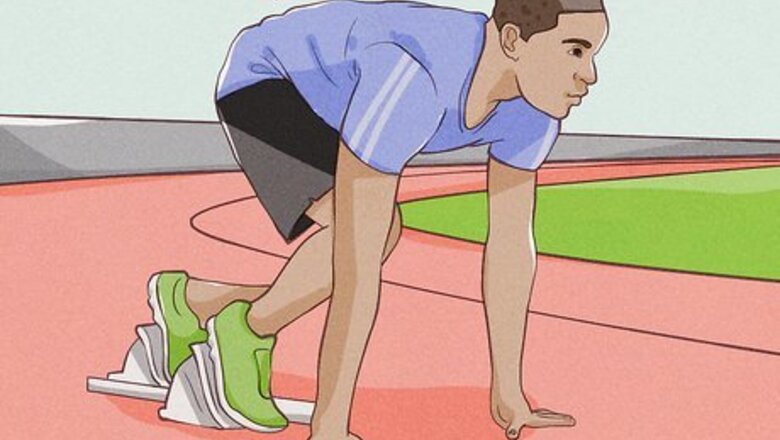
views
Learning the Form

Keep a neutral posture. Make sure that your head is in line with your spine, and that your shoulders, neck, and jaw muscles are relaxed. Maintaining a neutral posture will ensure you are using your body most efficiently, while also preventing any added stress to your body.

Point your entire body forward. Square your shoulders and hips in the direction of your sprint, and brace your core muscles. Point your toes forward as well, and avoid turning them outward, as this will interfere with your stride. Keep your eyes looking down on the track approximately 20 meters (65.6 ft) in front of you.
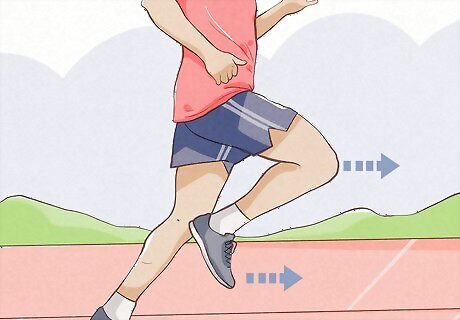
Drive your leading leg forward. The power in your legs will serve as the force behind your sprint. Take your first stride by pushing off with your toes and extending your dominant knee until it reaches a locked horizontal position above the hips. The angle between your shin and your foot should be at least 90 degrees, and your thigh should be parallel to the ground.

Extend your supporting leg. At the peak of your stride, when the knee of your lead leg has reached a horizontal position above your hips, the joints of your supporting leg - in your ankle, knee, and hip - should all be fully extended. Stand on the ball of the foot of your supporting leg with your heel slightly off the ground.

Land on the mid-foot. Aim to keep your landing foot about 2 to 4 inches (5 to 10 cm) in front of the hip to apply force on contact – more than this and you will break, too little and you will lose stability. After you land, drive your heel to your buttocks as your other leg drives forward, repeating the motions from the previous step. Alternating these strike-and-land steps will bring you to a stride. Executing these moves while gathering up as much energy as possible from your legs, arms, and core will bring you up to sprinting speed. Avoid striking your heel, or overstriding. Overstriding is inefficient for sprinting and can lead to serious foot or lower-leg injuries.

Bend your arms at a 65-degree angle. Your wrists should be straight. At the peak of your stride, your hand should approach the height of your nose; when your arm drives backward, your hand should pass your buttocks. Try to extend your fingers in order to increase the lever of your arm. Don’t ball your hands into fists or move them as fast as possible – this can disrupt your arm swing. All of your arm movement should drive forward from the shoulder joints. Keep your shoulders relaxed, and swing your arms smoothly. The power and frequency of your arm movements will directly impact the speed of your strides.
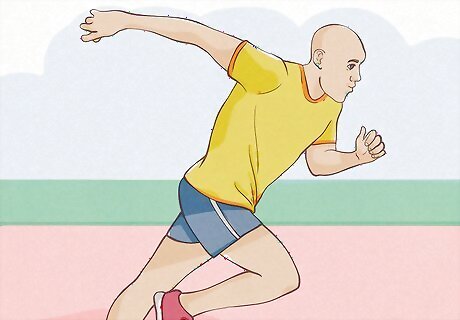
Coordinate your arm and leg movements. Your arms and legs should be balanced: when your lead leg moves forward, the arm on that same side should move backward. When your arms swing forward, they should stay close to your body, and when they swing backward, they can swing to a more open position. Avoid flailing your arms, as this will throw off your balance and waste energy.
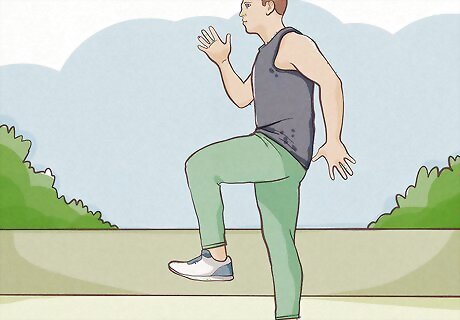
Practice your form. The mechanics of sprinting are very detailed, and may feel unnatural at first. Take some time to learn the form while you’re still a beginner in order to get faster on the track and avoid stress-related injuries. Use your warm-up as an opportunity to go through proper form at a slower pace. If possible, working with a trainer will help you learn proper form. Especially as a beginner, even one or two sessions will go a long way in helping you internalize the right movements. Try videotaping your sprint sessions and watching them after your workout to analyze your form and look for ways to improve.
Training for Sprints
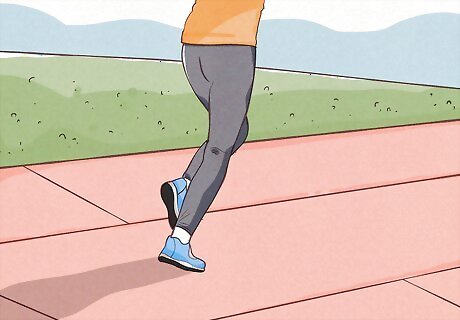
Train on a track or field. Run on a track (outdoors or indoors) if possible; if not, find a field with grass or astroturf. Avoid running on concrete or pavement, as these surfaces cannot absorb your body's impact as well as tracks and fields. While it is fine to train on treadmills, it's best to begin outdoors, where you will have a greater flexibility to work on your form.

Begin with a warm-up. Before any sprinting or running session, take some time to warm up your muscles. Start by jogging for at least 5 minutes, and then incorporate some dynamic stretching drills, including high knees, butt kicks, walking lunges, and skips. Once your body is warm, stretch your major muscle groups.
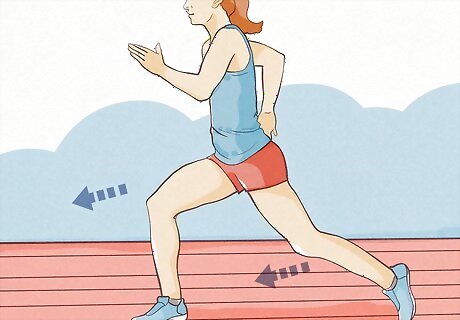
Run short-distance sprints. Devote certain training days to speed training by running a series of short sprints, under 100m each. Your sprint speed will increase when you devote workouts to pushing yourself to sprint as fast as you possibly can. On speed training days, you should focus on short, timed sprints, where you can track your progress and try to beat your previous speeds. Try a sample speed day workout to get started: Start by running 80m five times (5x80m), with a 3-minute recovery in-between. If you’re running on a track, run based on the markings the straight side of the oval track (the straightaway is 100m total); if not, be sure to measure and mark this distance. Follow your 80m sprints with 4x70m, 3x60m, 2x20m sprints, each with 3 minute recovery periods in-between sprints. Take 10 min break, drink some water, and let your pulse go down when you have finished the reps of each different sprint distance (i.e. between your 5x80m and 4x70m).
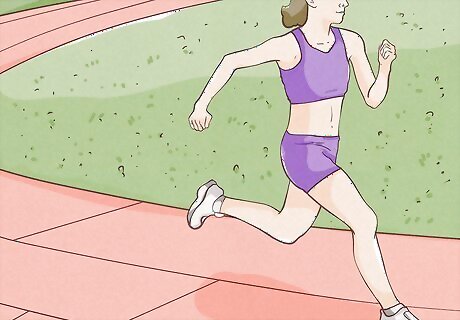
Practice long distance running drills. Perform endurance workouts to improve your heart rate, and thus your ability to sprint for longer periods of time. Devote certain training days to improving your stamina by pushing yourself to sustain your sprint pace for extended distances, with sprint lengths between 400-1200m meters. Try the following workout to get started: Jog a mile to warm up. Sprint one lap (400m) at a fast, controlled speed. Jog/walk until you catch your breath. Sprint two laps (800m) at a fast, controlled speed, and then three laps (1200m), taking time to jog/walk in between sets. Sprint two more laps at the same fast speed, and finish with one final lap. By the end of the workout, you will have counted both up and down from three full laps (1-2-3-2-1). Try jogging at a comfortable pace and slowly increasing your speed. Once you hit your maximum intensity, slow back down to a jog to build your endurance.

Cool down. After each workout, cool down by jogging for a few minutes, and performing dynamic and static stretching routines. Doing so will help prevent tightness in your muscles, which can cause pain or joint problems.
Conditioning Your Body
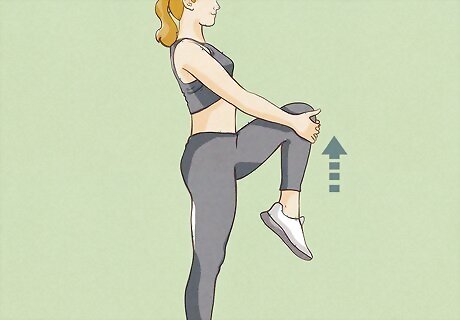
Increase your cardiovascular endurance. Incorporate lower intensity aerobic exercise into your workout routine in order to improve your blood flow and increase your stamina. Aim for thirty minutes of cardio exercise—such as jogging, biking, using an elliptical machine, or at-home aerobics—at least three times a week.
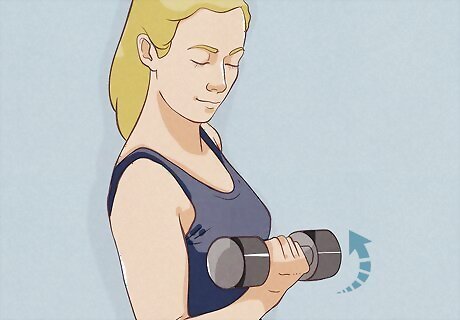
Train all major muscle groups. Although sprinters tend to focus on lower body strength training, it is important to train your core and upper body as well, as much of your sprinting power will come from these supporting muscle groups. Lift weights to build muscles and increase total-body strength. Warm up with light aerobic exercise before strength training workouts to avoid injury. When you hit the gym, designate different days to focus on lower body muscles (glutes, quads, hamstrings) and upper body muscles (chest, shoulders, back, biceps, triceps). Alternate lower and upper body workouts to give your muscles a chance to recover.
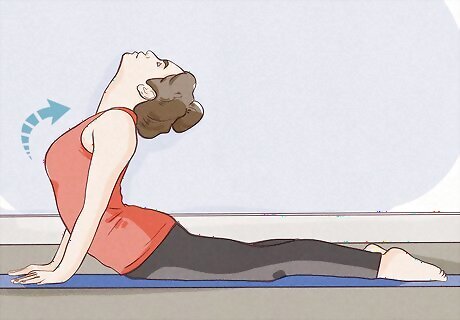
Improve your flexibility. Incorporate stretching routines into your training sessions to avoid injury. Stretch your muscles after a brief warm-up, and again once you’re finished with your workout. Consider adding a yoga practice into your regular conditioning routine.

















Comments
0 comment